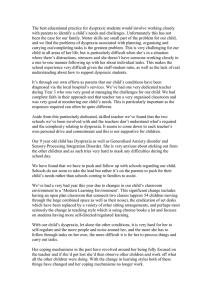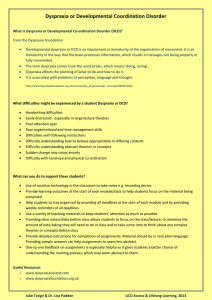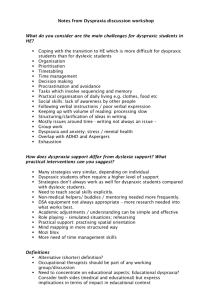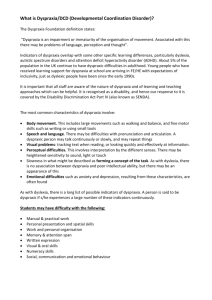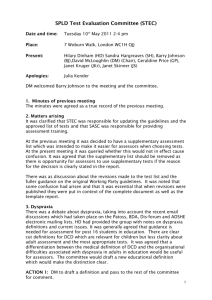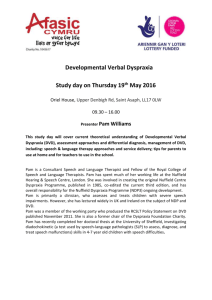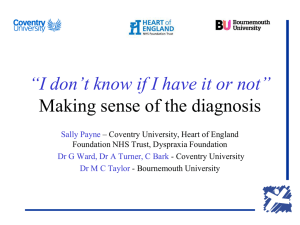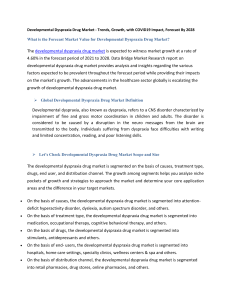Dyspraxia
advertisement
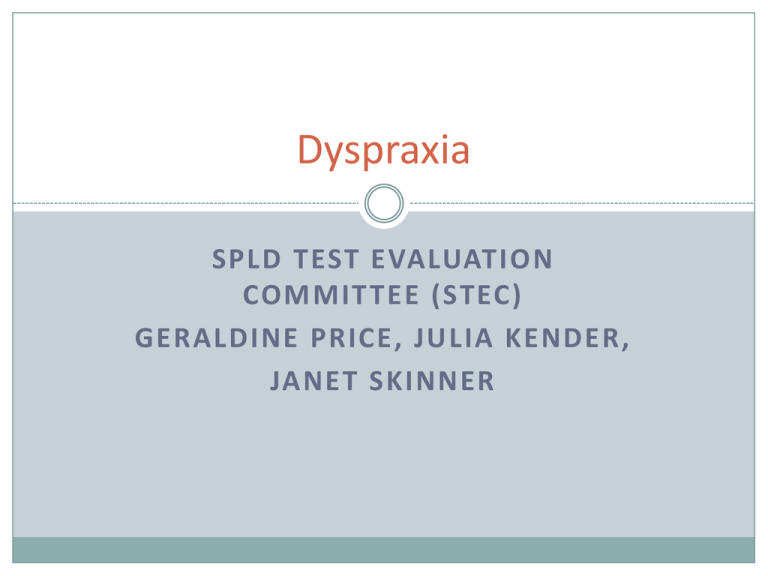
Dyspraxia SPLD TEST EVALUATION COMMIT TEE (STEC) GERALDINE PRICE, JULIA KENDER, JANET SKINNER Overview Discussion workshop on where we are in assessment and support of dyspraxia Education or Health? Practical interventions Working towards a definition Assessment tools The way forward Controversy Confusion among practitioners – very mixed messages Dyspraxia or DCD? Education or Health? Who is qualified to assess? What are we looking for? Overlap with other SpLDs Commonly agreed that dyspraxia often overlaps with other SpLDs Many challenges similar to that of dyslexic students – disorganisation; time keeping; managing workload; notetaking and handwriting organising ideas in written form; memory and attention span; visual & oral difficulties; maths & numerical Less likely to have difficulties with spelling and reading Challenges in HE? What do you consider are the main challenges in HE? How does dyspraxia support differ from dyslexia support? How can we work with students? Challenges in HE Some examples: Practical work – laboratories/placement Personal organisation – daily living; orientation around campus Work organisation; keeping to deadlines; following visual timetables Social skills – difficulty with social communication; group work Definitions Consider the definition What is useful? What is relevant? What would you add or omit from this definition? How important is the label/definition? How important are emotional issues? Importance of case history Questionnaires – http://www.boxofideas.org/ then choose ‘Practical skills at school: Further Education and University’ (Amanda Kirby) http://www.dyspraxiafoundation.org.uk/services/ad_sym ptoms.php http://www.brainhe.com/students/types/dyspraxia.html Example of questionnaire What questionnaires are in use in your institution? How helpful are they? Consider the questionnaire How could this be used in your institution? Assessment tools What assessment tools can we use as practitioners? How can we separate out medical and educational aspects of dyspraxia without involving multiple assessment? What conclusions can be drawn without a medical assessment of motor co-ordination difficulties? Assessment Questionnaire to gain history SASC diagnostic assessment tools Beery Test Visual Motor co-ordination Test of Visual Perception Skills (TVPS) Handwriting assessment/speed compared with speed on computer Final Considerations Specific learning difficulty consistent with dyspraxic profile? Specific learning difficulty of a dyspraxic nature? What guidance do you think would be helpful for assessors when updating SASC guidelines for assessors? Contact details Dr Geraldine Price Julia Kender Janet Skinner gap@soton.ac.uk j.kender@soton.ac.uk jps2@soton.ac.uk Further reading Drew, S (2005) Developmental Co-ordination Disorder in Adults London, Whurr Publishers Grant, D (2007) That’s the way I think: Dyslexia and Dyspraxia explained Abingdon, Routledge Kirby A, Edwards L, Sugden D, Rosenblum S, The development and standardization of the Adult Developmental Co-ordination Disorders/Dyspraxia Checklist (ADC) :Research in Developmental Disabilities 31 (2010) 131–139:Elsevier Hulme, C & Snowling MJ (2009) Developmental Disorders of Language Learning & Cognition Chichester, Wiley-Blackwell Further Reading contd http://www.boxofideas.org/ http://www.danda.org.uk/ http://www.dcd-uk.org/index.html (Leeds Consensus 2006) http://www.nha-handwriting.org.uk/index.htm
